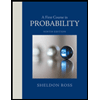
A First Course in Probability (10th Edition)
10th Edition
ISBN: 9780134753119
Author: Sheldon Ross
Publisher: PEARSON
expand_more
expand_more
format_list_bulleted
Concept explainers
Question

Transcribed Image Text:4. Suppose X1, X2,..., X10,000 are independent random variables with E(X;) = 8 and
Var(X;) = 4 for each i. Let Y = (X1+ X2 + ... +X10,000)/10,000.
a. Find E(Y).
b. Find Var(Y).
c. What does the Chebyshev inequality say about P(|Y – E(Y)| 2 0.1)?
Expert Solution
This question has been solved!
Explore an expertly crafted, step-by-step solution for a thorough understanding of key concepts.
This is a popular solution
Trending nowThis is a popular solution!
Step by stepSolved in 3 steps with 2 images

Knowledge Booster
Learn more about
Need a deep-dive on the concept behind this application? Look no further. Learn more about this topic, probability and related others by exploring similar questions and additional content below.Similar questions
- Let X1, X2, and X3 be uncorrelated RVs each with the same mean, µ, and variance, o?. Find expressions for the following in terms of the mean and variance: 1. Cov(X1 + X2, X, + X3). 2. Cov(X1 + X2, X – X2).arrow_forward4. Sixteen-ounce boxes of shredded wheat cereal packed automatically by machine are sometimes over- weight and sometimes underweight. The actual weight in ounces over or under 16 is a random variable X whose probability density is f(x) = c(4- x²) for -2 < x < 2, and 0 elsewhere. Negative values pertain to ounces under 16. Determine the constant c, and then find the probability that a box of cereal will be (a) more than one ounce underweight.arrow_forward1. Answer the following questions using the probability tree below: .2 .3 X .3 .8 a Y (a) What is the value of z? (b) What is the probability of X occurring? (c) What is Pr[Xa] (Note: Pr[Xa] = Pr[X and a].) (d) What is Pr[X_or a]? (e) What is Pr[a|X]? (f) What is Pr[c]?arrow_forward
- show that if X11, X12,..., X1, X21, X22,..., X2n₂ are independent random variables, with the first n constitut- ing a random sample from an infinite population with the mean μ₁ and the variance of and the other n2 constitut- ing a random sample from an infinite population with the mean μ2 and the variance o2, then 1 M2 (a) E(X₁-X₂) = μ₁ −μ2; 07 0 22 (b) var(X₁-X₂) = + n₁ n₂arrow_forwardSuppose (S, P) is a binomial distribution with n trials and probability of success p. Let X be the random variable X(k) = k³, where k is the number of successes. Calculate E[X].arrow_forwardQ1. let Y₁ < Y₂ < Y3 < Y4 < Y5 are the order statistics of the random sample of size 5 from the distribution : f(x) = 3x², 0arrow_forward
- Suppose X is a normal random variable with mean u = 17.5 and o = 6. A random sample of size n = 24 is selected from this population. a. Find the distribution of b. Find P(X < 14) and P(X < 14) Find P(15arrow_forward3. Determine the value c so that each of the following functions can serve as probability distributions of the discrete random variable X: a. f(x) = c(x² +4) for x = 0,1, 2, 3; 3 b. f(x)%3Dс for x= 0,1, 2 3-xarrow_forwardQ.3. Compute the probability that: (a) their sum is odd; (b) their product is even. Three distinct integers are chosen at random from the first 15 positive integers.arrow_forward
arrow_back_ios
arrow_forward_ios
Recommended textbooks for you
 A First Course in Probability (10th Edition)ProbabilityISBN:9780134753119Author:Sheldon RossPublisher:PEARSON
A First Course in Probability (10th Edition)ProbabilityISBN:9780134753119Author:Sheldon RossPublisher:PEARSON

A First Course in Probability (10th Edition)
Probability
ISBN:9780134753119
Author:Sheldon Ross
Publisher:PEARSON
